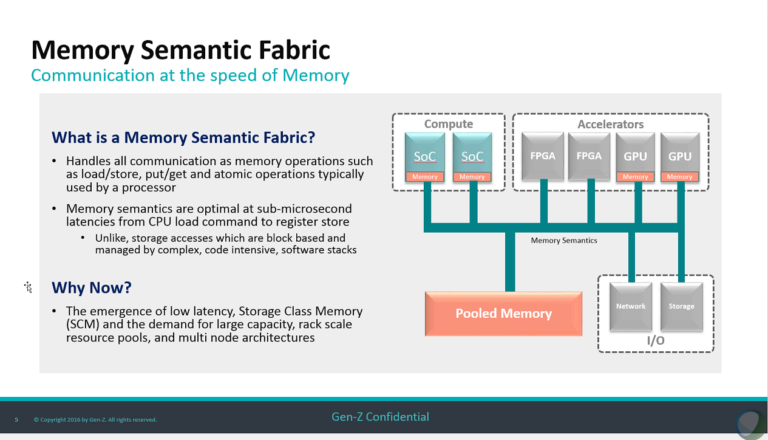Industry powerhouses have joined forces to address an issue that has confounded system architects since the advent of multicore computing, one that has gained in urgency with the rising tide of big data: the need to bring balance between processing power and data access. The Gen-Z Consortium has set out to create an open, high-performance semantic fabric interconnect and protocol that scales from the node to the rack.
Gen-Z
brings together 19 companies (ARM, Cray, Dell EMC, HPE, IBM, Mellanox, Micron,
Seagate, Xilinx and others) and bills itself as a transparent, non-proprietary
standards body that will develop a “flexible, high-performance memory semantic
fabric (providing) a peer-to-peer interconnect that easily accesses large
volumes of data while lowering costs and avoiding today’s bottlenecks.” The
not-for-profit organization said it will operate like other open source
entities and will make the Gen-Z standard free of charge.
Vowing
to enable Gen-Z systems in 2018, the consortium’s mission is to address what it
says are obsolete “programmatic and architectural assumptions”: that storage is
slow, persistent, and reliable while data in memory is fast but volatile,
assumptions the consortium contends are no longer optimal in the face of new
storage-class memory technologies, which converge storage and memory
attributes. A new approach to data access that takes on the challenges of
explosive data growth, real-time application requirements, the emergence of
low-latency storage class memory and demand for rack scale resource pools –
these are the consortium’s objectives.
Kurtis
Bowman, director, server solutions, office of the CTO, at consortium member
Dell EMC, said that 12 of the member companies have worked for the past year to
develop what he called a “.7- or .8-level spec” on the fabric, “so there’s
still opportunity for new members to contribute to the spec, make it stronger,”
but enough work has been done “with the spec in proving out that the technology
itself is right.”
“We
get asked a lot, ‘Why the new bus?’” he said. “It’s because there’s really
nothing that today solves all the problems that we think exist. One is that
memory is flat or shrinking in the servers that we have today. So the bandwidth
per core is shrinking to a point where today we have less bandwidth per core
than we did in 2003. The memory capacity per core is shrinking, the I/O per core
is shrinking. It really comes down to there’s just not enough pins on the
processor to be able to get the requisite amount of memory and I/O that you
need.”
He
emphasized the need to solve this challenge as real-time workloads are
increasingly adopted, “You have to be able to quickly analyze the data coming
in, get some insights from that data, because as it takes longer to analyze
that data, your time to insights pushes out and makes it less valuable. So we
want to make it so it’s easier to get compute and data closer together and
allow those to be done” in a standardized way, across CPUs, GPUs, FPGAs and
other architectures. “All of them need access to the memory that’s available.”
Gen-Z
touts the following benefits:
- High bandwidth and low latency via a simplified interface based on memory semantics, scalable to 112GT/s and beyond with DRAM-class latencies.
- Support for advanced workloads by enabling data-centric computing with scalable memory pools and resources for real time analytics and in-memory applications.
- Software compatibility with no required changes to the operating system while scaling from simple, low cost connectivity to highly capable, rack scale interconnect.
Gartner
Group’s Chirag Dekate, research director, HPC, servers, emerging technologies,
said the consortium’s focus on data movement has important implications on
high-growth segments of the advanced scale computing market, such as data
analytics and machine learning, that utilize coprocessors and accelerators.
“These
technologies are crucial in delivering the much needed computational boost for
the underlying applications,” Dekate said. “These architectures are biased
towards extreme compute capability. However, this results in I/O bottlenecks
across the stack.”
He
said coprocessors and accelerators utilize the PCIe bus to synchronize host and
device memories, despite there being roughly three orders of magnitude
difference between the FLOPS-rate and the bandwidth of the underlying PCIe bus.
“This essentially translates to dramatic inefficiencies in performance,
especially in instances where there isn’t sufficient parallelism to hide the
data access latencies,” said Dekate. “This problem is only going to get worse
as the computational capabilities of core architectures evolve more rapidly
than the supporting memory subsystems, resulting in a fundamental mismatch
between data movement within a compute node and the floating point rate of
modern processors.”
Initiatives
like Gen-Z are crucial for addressing the data movement challenges that
emerging compute platforms are facing, he said. “The success of Gen-Z will
depend on the consortium’s ability to expand and integrate broader scale of
processor vendors to be able to have the broadest impact in customer
datacenters.”
Gen-Z
said it expects to have the core specification, covering the architecture and
protocol, finalized in late 2016. Proof systems developed on FPGAs will follow
with fully Gen-Z enabled systems on track for mid-2018. Other consortium
members include AMD, Cavium Inc., Huawei, IDT, Lenovo, Microsemi, Red Hat, SK
Hynix and Western Digital.






